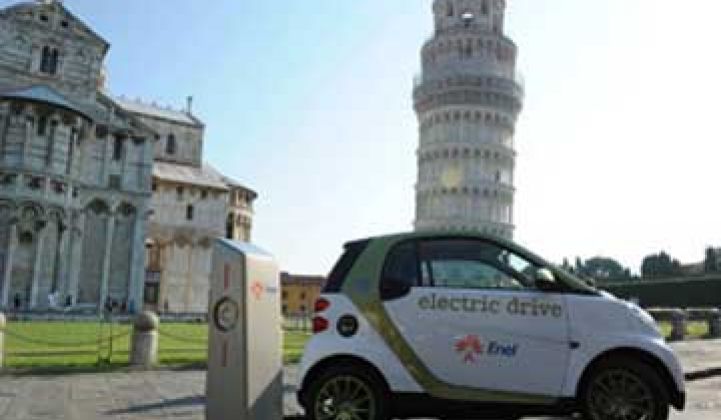When it comes smart grid, Italy is best known for its aggressive smart meter rollout. The country embraced advanced metering infrastructure mostly to cut down on theft, and not to empower customers, although that is starting to change. Enel, Italy’s largest electric company and the second largest in Europe, has installed smart meters for all of its 32 million customers.
Enel was out in front in meters, but the focus of stopping theft meant that more simplistic automatic meter reading, or AMR, technology was the choice in the early days. Although Enel continues to update their meters with the latest technology, the sheer volume of meters does not mean that it is a leader so far in layering applications on top of smart grid data.
But Italy, and Enel in particular, is gunning to be out front in a variety of smart grid areas, from EV integration to smart home integration and solar penetration. Here’s what to watch in Italy.
Renewable Energy. In 2010, Enel took its subsidiary, Enel Green Power (EGP), public. The company has more than 6,000 MW of capacity worldwide, including wind, hydro, geothermal and solar. “The company has concentrated all of its renewable generation in ENEL Green Power and has set an ambitious goal of doubling its wind capacity by 2020 and becoming a leading player in solar PV generation,” according to Geert-Jan van der Zanden, a European smart grid expert at GTM Research.
Solar. Solar is heating up in Italy, which had generous feed-in tariffs to help reach its goal of 30 gigawatts by 2020. There is some debate about how much is currently installed, with government figures being disputed by industry insiders. Either way, Sharp and EGP are opening a 160MW solar plant in the south of Italy, which is expected to be expanded to 210 MW by 2012. The government is also shifting the focus from large-scale to rooftop, although the current financial instability could undermine some of Italy's solar ambitions .
Energy@Home. Enel has partnered with Telecom Italia and Electrolux for a communications platform for a home area network that will allow for some of the value-added services that the metering hasn’t provided up until this point. The network will leverage its broadband gateway and Google is reportedly developing web applications.
Enel is also a leader in the European ADDRESS research project, which is looking to create a network that is “flexible, reliable, accessible and economic.” The project is developing an “energy box” for small and medium consumers -- including residents -- to join in energy markets, according to IEEE member, Lorenzo Peretto. The energy box will interface with everything from rooftop PV to dishwashers in order to balance the demands of the grid with distributed generation and end loads.
EV Integration. The electric vehicle plans of Italy are in line with other European countries, including Germany and France. Enel is part of the European G4V project and Green eMotion. The E-Mobility Italy project anticipates that one-third of participants will depend on public charging infrastructure. Enel has partnered with Daimler for pilots in Pisa, Rome and Milan (including 400 charging stations) that will seek to identify the right mix of charging and how to centrally control charging to mitigate grid impact.
Italy is also further ahead than many other European countries on distribution automation, something that it will continue to focus on as it prepares its grid for EV integration.
For more information about Italy’s smart grid and other countries in Europe, look for GTM Research’s upcoming report, "The European Smart Grid 2012-2016: Technologies, Market Forecasts and Utility Profiles." Also check out the first installment in this series, Smart Grid Australia.



